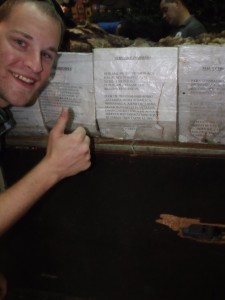I really don’t have anything to report about parasites in Costa Rica yet, or religion for that matter, but we did arrive yesterday to begin preliminary data collection for the Costa Rican Religious Ecology Study, as I’ve been calling it. I’m here with Max Stein, a Ph.D. student in biocultural medical anthropology at UA, & Andrew Bishop, who is going into the graduate program in the School of Evolution & Social Change at Arizona State University in the fall. We’re in San Jose today to get permission from the Ministry of Health & will be traveling to Limon tomorrow to begin data collection.

Max did his master's project on nervios in Honduras & was excited to find evidence of it (or its treatment) here in Costa Rica ("cool! people suffer the same illnesses here!")
While we don’t have anything currently to report, one goal of this trip is to develop methodology for testing Fincher & Thornhill’s parasite-driven wedge hypothesis in situ, which I’ve discussed in previous posts (HBES Roundup 4 & Religious Ecology Study). After talking to Fincher & Thornhill at HBES, one way we’d like to try to do this is using Duncan & Schaller perceived vulnerability to disease questionnaire & an abbreviated & modified Wilson-Patterson conservatism scale. Another more intensive approach we’re going to attempt is via cultural consensus modeling re assortative sociality (who folks choose to socialize with) & dispersal (do you travel? where do you go? how often? how far?). And more generally, we’re interested in the ecology of the religious environment. Why do people choose to go to the church? What do they get out of it? What do they need to put into it? What is the history of the church? What niche or need was it established to fill? We’re sampling by churches in a few neighborhoods, focusing on Charismatic churches, since my previous research experience is with such churches. We’re focused in Limon province because of the Afro-Caribbean ancestry of its residents, the higher rate of bilingual English-Spanish speakers, the generally lower socioeconomic status of its residents, & the moderate presence of malaria & dengue fever in the region. It’s also just a really awesome field site!
One question or concern others have raised & that we share is that colonialism has transformed the region so recently & completely, evolutionary explanations for current behavior based on the ecology may be irrelevant. On the one hand, Fincher & Thornhill have found relationships between latitude/parasite load & cultural diversity regardless of the history of colonialism. Thus, the idea is not that people act a certain way because historically pathogens were a problem & its coded in their genes. The idea is that people have a behavioral immune system that kicks in when pathogen loads are high (as born out in experimental research when people are primed with disgust). So people in areas with higher pathogen loads & less access to medical resources should hypothetically act differently than people in areas with lower pathogen loads & more healthcare access, regardless of their ancestry. On the other hand, perhaps ancestry also plays a role. The advantage of Limon in that regard is that there are numerous ancestral groups present, including not just Afro-Limonenses & Hispano-Limonenses but also indigenous groups like the Bribri, who I’d love to include in the study somehow.
Anyway, so far we’ve just learned that local Tico kids kick our asses at foosball (actually, I declined the indignity of having my ass handed to me, but apparently there’s a skill to passing the ball back & forth to you own players & shooting & enjoyed watching Max & Andrew’s endeavors in participant-observation). We learned that if you act like you don’t speak much Spanish when dealing with bureaucrats, they’re more inclined to be helpful. We also learned that I should have mailed our interview materials earlier or just paid to check the box because it’s still not here & we may have to shell out to reprint it all. Oh, & I learned that the rental car being cheaper than the cost of all of us taking buses everywhere was too good to be true because they kill with a hidden compulsory insurance charge. BUT, I also learned that one of my key informant’s best friends is a pastor in Puerto Viejo, where many of her congregants speak English, & my informant’s son now rents out cabins right by the beach that may be a good deal for us (last time I slept on his couch, which was great & nice, but now there are 3 of us).

Pingback: Costa Rican Religious Ecology Study: Bringing in the Bribrí | Welcome to the EvoS Consortium!